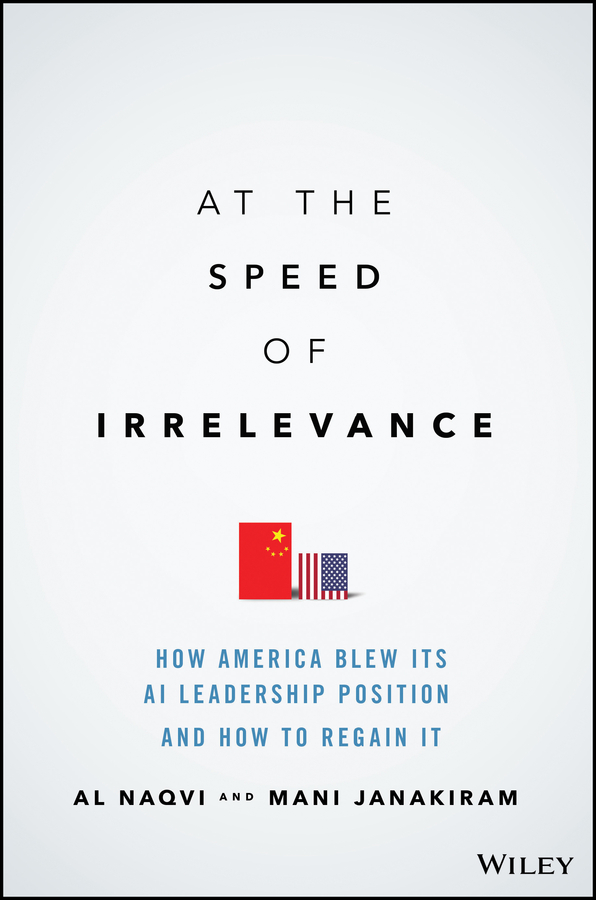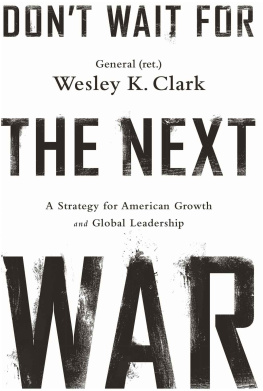
Table of Contents
List of Illustrations
- Chapter 1
- Chapter 5
- Chapter 6
- Chapter 8
- Chapter 12
Guide
Pages
At the Speed of Irrelevance
How America Blew Its AI Leadership Position and How to Regain It
AL NAQVI
MANI JANAKIRAM

Copyright 2022 by John Wiley & Sons, Inc. All rights reserved.
Published by John Wiley & Sons, Inc., Hoboken, New Jersey.
Published simultaneously in Canada.
No part of this publication may be reproduced, stored in a retrieval system, or transmitted in any form or by any means, electronic, mechanical, photocopying, recording, scanning, or otherwise, except as permitted under Section 107 or 108 of the 1976 United States Copyright Act, without either the prior written permission of the Publisher, or authorization through payment of the appropriate per-copy fee to the Copyright Clearance Center, Inc., 222 Rosewood Drive, Danvers, MA 01923, (978) 750-8400, fax (978) 750-4470, or on the web at www.copyright.com. Requests to the Publisher for permission should be addressed to the Permissions Department, John Wiley & Sons, Inc., 111 River Street, Hoboken, NJ 07030, (201) 748-6011, fax (201) 748-6008, or online at http://www.wiley.com/go/permission.
Limit of Liability/Disclaimer of Warranty: While the publisher and author have used their best efforts in preparing this book, they make no representations or warranties with respect to the accuracy or completeness of the contents of this book and specifically disclaim any implied warranties of merchantability or fitness for a particular purpose. No warranty may be created or extended by sales representatives or written sales materials. The advice and strategies contained herein may not be suitable for your situation. You should consult with a professional where appropriate. Further, readers should be aware that websites listed in this work may have changed or disappeared between when this work was written and when it is read. Neither the publisher nor authors shall be liable for any loss of profit or any other commercial damages, including but not limited to special, incidental, consequential, or other damages.
For general information on our other products and services or for technical support, please contact our Customer Care Department within the United States at (800) 762-2974, outside the United States at (317) 572-3993 or fax (317) 572-4002.
Wiley also publishes its books in a variety of electronic formats. Some content that appears in print may not be available in electronic formats. For more information about Wiley products, visit our website at www.wiley.com.
Library of Congress Cataloging-in-Publication Data is Available:
ISBN 9781119861270 (Hardback)
ISBN 9781119861294 (ePDF)
ISBN 9781119861287 (ePub)
COVER DESIGN & ILLUSTRATION: PAUL McCARTHY
For Nur, Mahek, and Marya
Dr. Al (Ali) Naqvi
Dedicated to my wife, my son, and my parents
Dr. Mani Janakiram
Preface
AS THE REVERBERATIONS ABOUT China's ascendency over the United States in artificial intelligence are coagulating, America mustconsider the root causes of falling behind. The popular narrative is about China doing something magical to close the technological gaps. This book argues that America is losing the AI competition not because China is doing something extraordinary but because the American national strategy for AI is flawed.
There are many books on AI. There are many books on China's rise. But there is no book that explains why America is lagging in AI. Developing that perspective requires taking a bold stand and applying critical thinking.
We observed an overwhelming concern about China's rise in AI. From Congress to various government agencies, the threat of China's advancement in AI has led to rapid and hasty reactions and policies. But none of those reactions have taken a critical approach to uncover what are the root causes of falling behind.
The American Institute of Artificial Intelligence captures the adoption of AI across economies, industries, governments, companies, and agencies. Professor Naqvi is the CEO of AIAI and has authored several books on industrialization of AI. He is an AI industrialization expert. Dr. Janakiram offers a unique understanding of the semiconductor value chain. Bringing both ends of the spectrumthe AI software and the AI hardwarethe authors take a critical approach to analyze the descent of American AI.
In our discussions with many Americans knowledgeable about the AI competitive dynamics, we observed tremendous unease about the Chinese AI advantage and the damage it will cause to American competitiveness in the long run.
We do not believe that ignoring what has transpired in the past will restore the future. Unless corrected, the mistakes of the past will shape the future. America will struggle to rise back up to the leadership position and that will impact every other aspect of nation building. From political turmoil to economic decline and from social meltdown to national security collapse, AI has the power to impact all aspects of human life and institutions. Loss of leadership in AI implies a loss in everything else. Despite the importance of this technology, little planning went into how AI should be launched and socialized in America at a national level.
In America, the AI technology was launched with a narrative that repels rather than attracts interest, an R&D plan that constrains national adoption rather than encourage it, a national strategy that destroys value instead of increasing it. The result is a technology development model that favors monopolies and elite universities at the expense of American innovation and the American public. This creates social and economic inequality, wealth disparity, poverty, and plutocracyand it weakens democracy.
The plan to restrict access to AI and to limit its nationwide growth has fallen on its face. Adversaries who may not have been liberal democracies have both liberated and democratized AI and solidified the future of their countries. America remains mired in its problems, uninterested, and uninspired about the greatest change ever in human civilization.
We also argue that the fundamental R&D system is due for a change in America. America has already experienced three R&D systems in the twentieth century. The R&D system includes both its processes and the funding model, and AI is changing both. Despite that, the investment model and approach of the Office of Science and Technology Policy (OSTP) remain antiquated. The OSTP appears as the greatest barrier to success in American AI. The office has overstepped its responsibility and has trodden into areas where it does not have any expertise: strategy development. In the end, the failed policies of OSTP are harming American national interests and giving China an easy victory.
We conclude the book by recommending an alternative path. Our tone in this book is critical and at times harsh. But that is intentional. We want the audience to recognize the importance of getting this right. America must move at the superspeed of relevance. Time is running out.
Acknowledgments
WE WOULD LIKE TO thank the Wiley team, our publisher, for being extremely helpful, understanding, and efficient with our project. Specifically, we would like to thank Sheck Cho and Susan Cerra. For topics like AI, there are many choices to partner with reputable publishers. We partnered with Wiley because of the excellent support we receive in all steps of the publishing process. One of the authors has published two other books on AI with Wiley and his experience has been excellent.
Next page








